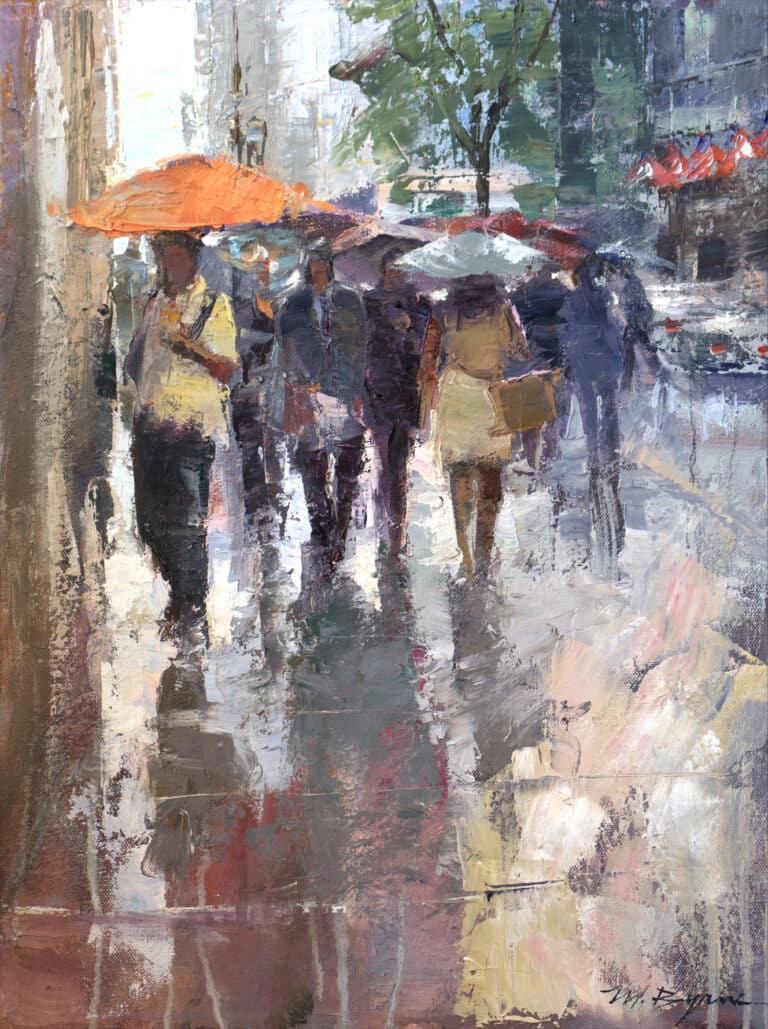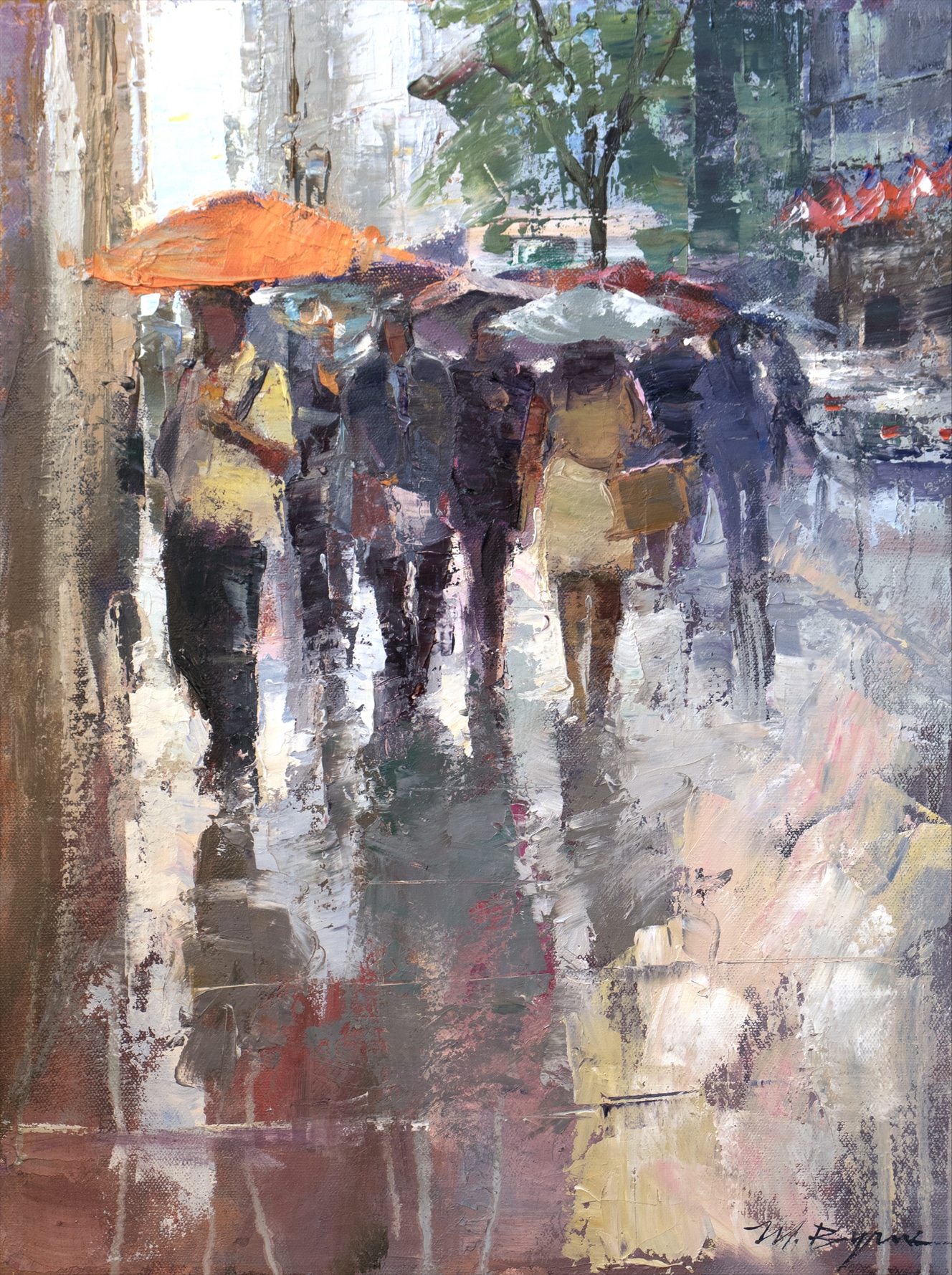
The Essence of Place
Michele Byrne
BY
Michael Dorogi
Michele Byrne has the rare ability to capture the story within a story. There is an overriding sense of narrative to her work, as if the figures in her paintings are rushing off to tend to their complex, secret lives, and the viewer is fortunate enough to tag along. She gravitates towards painting people and street scenes. The human figure, specifically, has been a subject that has long held interest for her.
“I’ve always had a passion for depicting people in my art,” Byrne reveals. “I used to attend figure painting sessions regularly, and during a trip to Jamaica with my friends, I experimented with watercolors and incorporated the locals into most of my pieces. I suppose that was the start of this artistic journey.”
Her first realization that art was something she was both talented at and passionate about came very early on, in kindergarten, actually, when a teacher praised her work. “From the moment I heard my kindergarten teacher declare, ‘Michele is a great artist’, my aspiration to become an artist was ignited,” Byrne says. She spent many hours on her own growing up and found herself occupying her free time with art. Then, at age eight, this passion was stoked again by a visit to a barn in the Pennsylvania countryside.
“I had only one friend my own age. Since my brother and sister were older, I had lots of time on my own. My parents saw my love for drawing and took me to an oil painting class at age eight. It was on the top floor of a barn, and it was mostly adults. I absolutely loved it!”
As years passed, Byrne studied many art and artists. One artist she discovered that continues to inspire her painting is Henri de Toulouse-Lautrec. Lautrec’s influence is quietly expressed in her work, yet does not overpower or define it. She has moved beyond the strict, contour line renderings of earlier artists and into a more abstract form of modern impressionism. She attributes much of her stylistic shift to painting en plein air.
“At the start, my studio paintings were meticulously detailed – to the extent that you could tally the foliage on trees. However, in 2018, I encountered a marketing professional named Barbara Dougherty from Maryland, who motivated me to attend my first plein air painting event. Although I had previously painted outdoors using watercolors, I was unfamiliar with the term ‘plein air’. The initial event I took part in was located in Snow Hill, Maryland. It proved to be incredibly fun as I incorporated human figures into my works, and I believe one of them was sold.”
The time constraints and shifting light of plein air forced Byrne to loosen up, break edges, describe a whole figure in a blot of orange and a spot of violet. The use of a pallete knife is also instrumental in her style. Whereas, some artists might reserve the knife for highlights, Byrne utilizes it for much of the painting process.
“I use both brush and knife. Typically, I’ll use a brush with just a few dark transparent colors to draw my initial composition onto the canvas or panel. After that I jump in with the knife. Or, on some occasions when I’m unsure of the colors, I’ll mix the colors and place them on the piece to test it. From there, I’ll move into the knifework.”
Although it may appear that her work is done in a flurry of unbridled creativity, Byrne strategically plans out her paintings, even in plein air. She actually employs a grid system to map out her composition before she begins. Additionally, she stresses the importance of a value study prior to putting paint to canvas.
“About ten years ago, I did some intense studying of composition with a young man from Pennsylvania who had a business called the Academy of Composition. He had studied with Myron Barnstone. I learned all about Dynamic Symmetry, the golden spiral and the Fibonacci numbers. It was a real eye opener for me, and to this day I almost always draw a grid on my canvas before I start. In my studio work, I design my pieces using this system. For plein air, if I have the time, I’ll draw a grid and use it for a starting point and for a few of the elements within the work. I also am adamant about doing a small value study or ‘thrust map.’ If I have a design and placement in mind before I start, I have a much better chance of creating a dynamic painting,” Byrne states.
After the initial design phase of a painting, she proceeds to an underpainting. Byrne focuses on values in this early stage.
“I paint the underpainting with two transparent colors and work to get the values correct. Usually, I start with Transparent Oxide Red and either Ultramarine Blue or Permanent Green Deep (Cobra Oil paint color similar to Viridian). From there, I work a few different ways. Sometimes, I jump right into using the palette knife. Other times, I figure out my colors and place them loosely on the canvas with a large brush. When I’m happy with the colors, I use the knife to add more paint and move it around and manipulate it the way I see fit.”
Byrne lays and scrapes paint onto the canvas, transfixed by the experience of creating until she determines she can’t progress the piece any further. In plein air, this is usually due to some obstacle like weather or fading light.
“I take my paintings as far as I can in the field and then I like to take them home and place them in my studio where I can look at them often. After a few days, I may know what I need to do to finish it,” Byrne states. However, I try not to work on plein air pieces too much in the studio, because often it kills the immediacy of the piece, especially the figures.”
Byrne is interested in abstraction. In fact, she sees abstract painting as something she wants to move towards in the future. She likes to play with the idea of what is essential in a painting, and what is unnecessary detail.
“Frequently, I find myself incorporating excessive details, which subsequently require me to remove or blur them. This has been a persistent challenge for me throughout the years. Primarily, I strive to confine the details to the central point of interest, while squinting to diminish the peripheral areas.”
This ability to capture the essence of a scene without being literal is a skill that took many years for Byrne to develop. When students ask how they can improve their painting abilities, Byrne emphasizes the value, not only of hard work, but of the willingness to learn from your mistakes.
“Practice drawing, learn to use values and learn color relationships. Do lots and lots of paintings and make lots of mistakes. That is how we learn. You will remember what you did wrong on your next painting expedition. The more mistakes you make the more you will learn. Remembering what I did wrong previously, helps me improve my craft.”
Byrne has been teaching students the methods of her craft for years, but this year is different. She is thrilled to soon host classes from the comfort of a brand new, built to specs studio, which is attached to her Santa Fe home. Here, she plans to both teach and explore her work on a larger scale.
“I’m looking forward to painting larger canvases and exploring painting with large brushes using different techniques.”
Byrne is always growing as an artist, evolving with her work. There is a sense of restless curiosity to her paintings, as if the artist is discovering the work just as the viewer might. This constant state of becoming is something she embraces.
“I never run out of ideas. I’m always trying to learn and experiment and become more abstract with my work. I truly believe there is always more to learn, and I take a workshop every few years with an artist I admire. I’m constantly looking at art books for inspiration. If we become set in our ways and continue to paint the same subjects in the same style, I believe that is problematic.”
Though her art is always evolving, her vision as an artist remains constant. She knows what she hopes to capture in her work.
“I hope to capture the essence of place, and a story within that place.” As for the viewer, she is conscious of what she wants them to experience as well. “I want my work to create feelings of joy or inspiration to the viewer. My work will often jar a memory of a happy time or place in someone’s life. I prefer to spread joy and happiness.”
Michele Byrne does indeed capture the essence of place in her work. She compels the viewer feel what it would be like to walk in the rain on a dreary, New York day, or stroll past adobe houses in downtown Santa Fe. The people and places in her paintings come alive and welcome us into their fascinating worlds, bursting with light and color and raw emotion. Her work inspires. Her work pushes the boundaries. Her work spreads joy.

